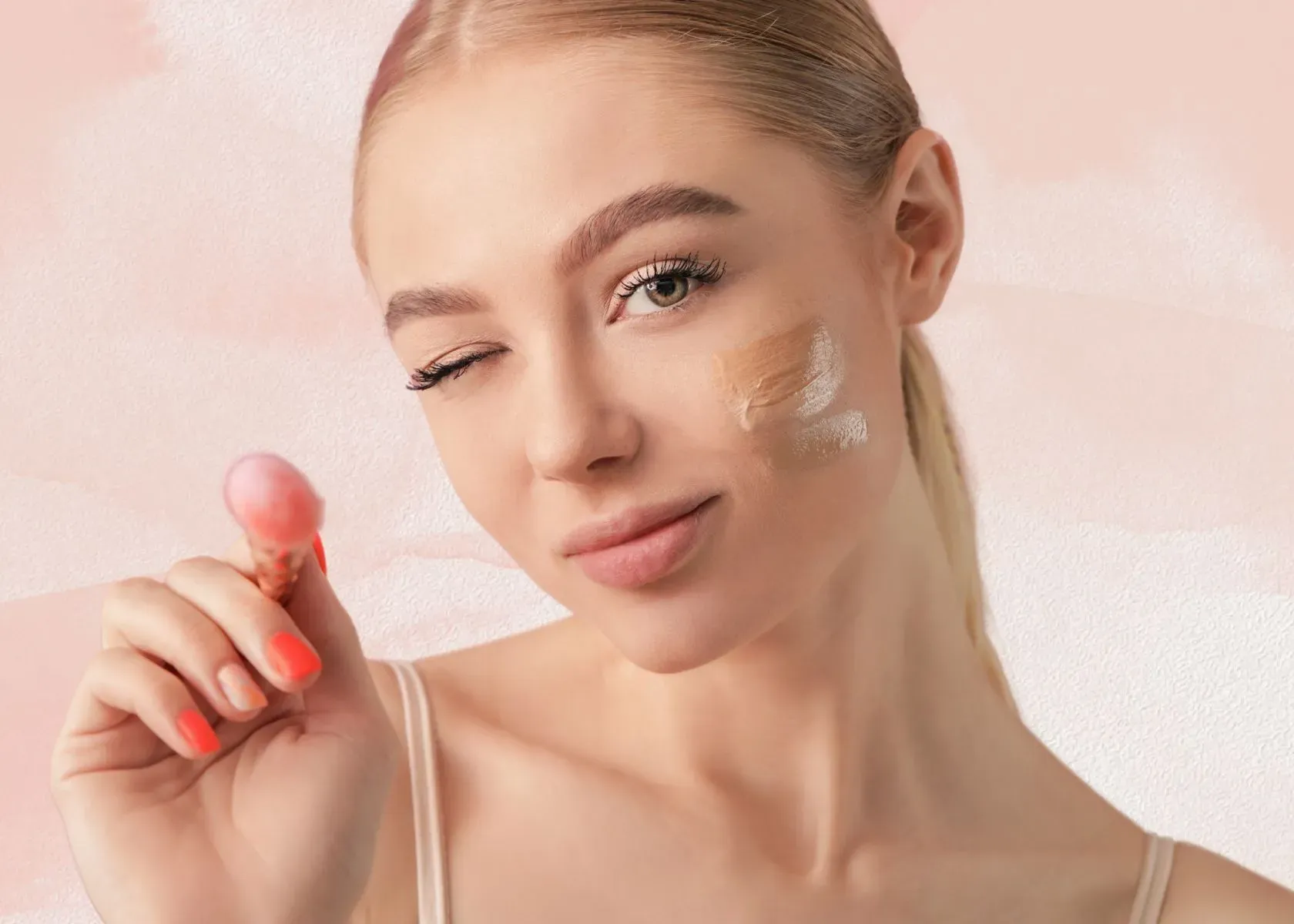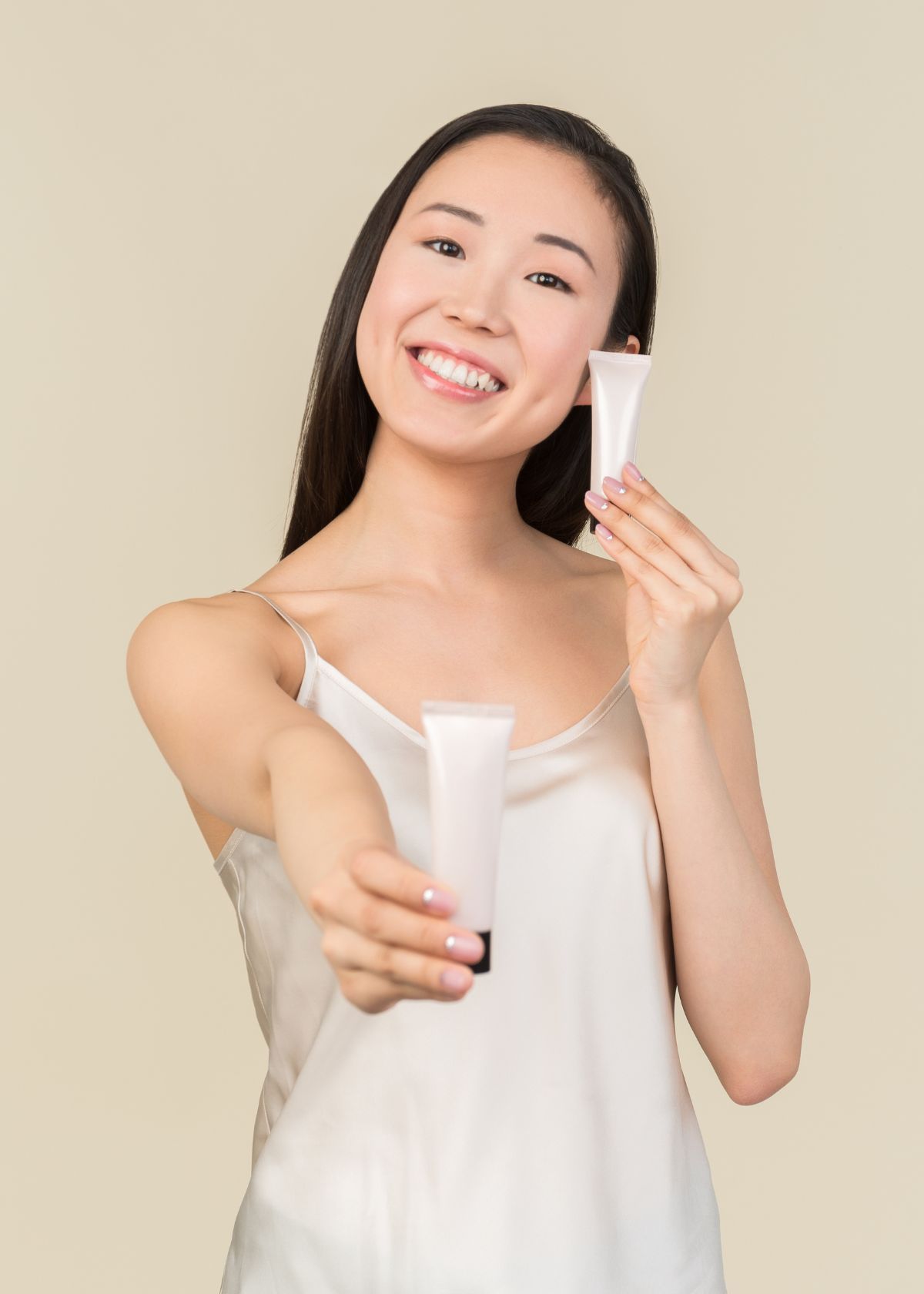Are you tirelessly searching for that holy grail foundation application, only to end up with a face that looks more like a patchwork quilt than a masterpiece? Trust me, this is a familiar tale.
Getting your foundation right is a tricky business – one moment, it's settling into every nook and cranny, and the next, it seems to have vanished into thin air.
I can relate because I've found myself frozen in the beauty aisle too many times, surrounded by an endless sea of products, without knowing why my makeup routine was falling short.
The lightbulb moment didn't happen until I dove headfirst into the world of cosmetics and unearthed the secret: it's all about setting the stage properly for your makeup.
In this blog post, we're going on a skincare journey together. I'll guide you through prepping your canvas - yes, that lovely skin of yours - ensuring it's pristine and eager for what comes next.
We'll discuss picking out just the right type of foundation magic for your skin needs and divulge some professional tips for achieving that ultra-smooth finish others will swear is au naturel.
Let’s get ready to channel our inner beauty guru!
- Choose a foundation formula that matches your skin type and concerns, like oily, dry, or combination skin, for the best results.
- Use tools like brushes, sponges, or fingers to apply foundation evenly and create a finish that's either dewy or matte based on personal preference.
- Always start with a primer to smooth out imperfections and help makeup last longer without needing frequent touch-ups.
- Apply foundation in light layers to avoid a cakey look; it's easier to add more coverage if needed than remove excess product.
- Select the right shade by testing on your jawline in natural light for an undetectable blend between face and neck.
Preparing Your Skin for Foundation

Before applying foundation, preparing your great skin for a smooth and flawless application is important. This includes cleansing and moisturizing, exfoliating and hydrating, and using a primer to create a perfect base for your foundation.
Cleanse and Moisturize
Every flawless foundation routine starts with a clean canvas. I wash my face with a gentle cleanser to remove dirt, excess oil, and any leftover makeup. Cleansing helps prevent breakouts and ensures that the foundation will go on smoothly.
After patting my skin dry, I apply a lightweight moisturizer to hydrate it thoroughly. Hydrated skin means fewer flakes and less chance of cakey foundation later on.
I pay special attention to areas that tend to get dry, like around the nose and forehead. It's essential because it promotes even coverage and regular moisturization addresses specific skin concerns over time.
By locking in moisture early in my skincare regimen, I set myself up for success before reaching for that bottle of foundation.
Incorporating a daily moisturizing practice keeps my complexion looking radiant beneath makeup or when going bare-faced. A good-quality moisturizer can be beneficial regardless of whether you have oily or dry skin.
It balances your natural oils and prevents the appearance of excess oils throughout the day - a crucial step toward achieving that sought-after flawless finish with ease.
Exfoliate and Hydrate
After ensuring a clean canvas, cleansing and moisturizing, exfoliation, and hydration are the following steps to prepare the skin for flawless foundation application. Exfoliating the skin helps remove dead skin cells, promoting a smoother texture and even tone.
This process also aids in preventing clogged pores, resulting in a more seamless foundation application. Hydrating essence or serum can further enhance the skin's moisture levels, creating a supple base for foundation that diminishes dry patches for an immaculate finish.
Regular exfoliation and proper hydration cater to specific skincare concerns and ensure that your foundation adheres smoothly to your skin.
By gently buffing away dullness through exfoliation and replenishing moisture with hydrating products, you pave the way for flawless makeup application while nurturing healthy-looking skin beneath your makeup.
Use a Primer
Before applying foundation, using a primer can help create a smooth base for makeup application. It helps minimize the appearance of pores and fine lines while ensuring your foundation stays put throughout the day.
Some primers also provide added benefits, such as color correction or hydration, catering to different skin concerns. Incorporating a primer into your routine allows you to achieve a flawless, lasting foundation application.
Choosing the Right Foundation Formula

When it comes to choosing the right foundation formula, it's important to consider your skin type, and coverage needs and find the perfect shade that matches your complexion. These factors play a crucial role in achieving a flawless and natural-looking finish.
Consider Skin Types
Before selecting a foundation, it's crucial to consider your skin type. If you have oily skin, look for oil-free or mattifying formulas to minimize shine throughout the day. For dry skin, opt for hydrating foundations that provide moisture and prevent flakiness.
Individuals with combination skin should choose a foundation that balances both oily and dry areas. Understanding your skin type will guide you in choosing the right foundation formula, ensuring a flawless finish.
When selecting a foundation, it's also essential to consider any specific concerns, such as acne-prone or sensitive skin. Look for non-comedogenic and hypoallergenic options for acne-prone or sensitive skin to prevent breakouts and irritation.
Considering these factors will help you find the perfect foundation that suits your needs and ensures a smooth application process.
Choosing the right foundation formula is key to achieving flawless results while considering individual skincare needs - from hydration to managing oily zones - ensuring an impeccable base for makeup application.
Determine Coverage Needs
To determine coverage needs, it's essential to consider individual skin concerns and the desired finish. Understanding whether you want light, medium, or full coverage will guide your foundation choice.
For example, if you have blemishes, discoloration, or dark undereye circles that you want to conceal, a full-coverage foundation may be suitable. Assessing your preferences based on your daily activities and the overall look you wish to achieve is crucial.
Factors such as dryness or oiliness of the skin can also influence coverage needs. Additionally, personal preference towards a natural finish or a more polished look will help decide the level of coverage required for flawless results.
Once these considerations are made, selecting the appropriate foundation formula becomes easier.
Check for Shades
After determining the coverage needs and considering your skin type, it's crucial to check for shades when choosing the right foundation formula.
Knowing your undertone is essential in selecting a shade that seamlessly blends with your natural skin tone and delivers a flawless finish.
Pay attention to whether you have warm, cool, or neutral undertones, as this will guide you in finding the perfect match for your complexion.
Additionally, consider testing foundation shades on your jawline and neck to ensure a seamless transition between your face and neckline for a natural look.
When exploring foundation options, consider any specific skin concerns, such as redness or discoloration, which may require color-correcting foundations.
By considering undertones and specific concerns, you can confidently select the ideal shade that enhances natural beauty while providing flawless coverage.
Application Techniques for a Flawless Finish

I will discuss the best techniques for applying foundation, including using fingers, a brush, or a blending sponge. Read more for expert advice on flawless foundation application!
Using Fingers
I apply foundation with my fingers, starting at the center of my face and blending outwards. I find that using my fingers warms up the product and helps it meld seamlessly into my skin.
It's important to wash your hands with your fingers before applying foundation to prevent transferring any dirt or oils onto your face.
When using my fingers for application, I start with a small amount of foundation and build up coverage as needed. This technique gives me more control over the finish and ensures a natural look without cakiness.
Using a Brush
To apply foundation with a brush, I use a flat foundation brush to distribute the product across my face evenly. The brush helps to blend the foundation seamlessly, ensuring a smooth and even application.
Using gentle strokes in a downward motion, I work outward from the center of my face to achieve a natural look.
Applying foundation with a brush allows for more precise coverage and helps to minimize streaks or lines. Additionally, a clean makeup brush is essential for preventing bacteria buildup and achieving flawless results.
Remember, choosing the right type of brush based on your preferred coverage and finish can make all the difference in how your foundation looks.
My key suggestion is to apply the base using a soft, fluffy brush to achieve a flawless matte foundation finish.
Using a Blending Sponge
I love using a blending sponge or beauty blender for applying foundation because it creates a smooth and even finish. This tool helps to blend the foundation seamlessly into the skin, avoiding streaks or patchiness.
The dabbing motion with a blending sponge also ensures the product is evenly distributed, providing a natural-looking complexion. Incorporating this tool into your makeup routine can help you achieve flawless results with minimal effort.
Tips for Different Finishes

When aiming for a dewy finish, use a hydrating primer and apply a liquid foundation with a damp blending sponge. For a matte finish, opt for an oil-free primer and utilize a dense makeup brush to create an airbrushed look.
Set your foundation with setting powder and finishing spray for added longevity to achieve long-lasting wear.
Dewy Finish
I always opt for a foundation with a luminous or hydrating formula to achieve a dewy finish. However, skin prep is the essential step even before this.
Foundations with light-reflecting particles or moisturizing properties can help create the desired radiant and dewy look.
When applying foundation for a dewy finish, consider using a damp blending sponge to seamlessly blend the product into your skin for a natural glow.
Additionally, adding a few drops of liquid highlighter to your foundation can enhance the luminosity and contribute to achieving that coveted dewy finish.
When aiming for a dewy complexion, it's important not to over-powder your face, as this can diminish the glow and radiance. Instead, focus on strategic powder application only where needed, such as the T-zone area if you have oily skin.
Matte Finish
Choose a foundation formulated to control oil and minimize shine for a matte finish. Look for keywords like "matte," "oil-free," or "mattifying" on the packaging. This type of foundation is ideal for those with oily or combination skin.
Using a primer specifically designed to mattify can also help create a smooth base for your foundation.
When applying a matte finish foundation, use techniques that promote an even application and reduce the appearance of pores and fine lines. I recommend blending the foundation well with a brush or makeup sponge in thin layers to avoid any cakey build-up.
Also, consider setting your matte foundation with a translucent powder or loose powder to lock in the finish and increase its staying power throughout the day. You can top it up with just the right amount of powder blush for a healthy flush.
Long-Lasting Finish
To achieve a long-lasting finish, I recommend choosing a foundation that is specifically designed for longevity. Look for keywords like long-wear, 24-hour, or high-performance on the label.
Consider using a setting spray to lock in your foundation and extend its wear time throughout the day. Finally, if you have oily skin or struggle with makeup fading, opting for an oil-free or mattifying foundation formula can help maintain a fresh and flawless look.
Applying thin layers of foundation and allowing each layer to dry before adding more can also contribute to a longer-lasting finish. By doing so, you can build coverage while ensuring your makeup stays put without looking heavy or cakey.
Frequently Asked Questions - Flawless Foundation Tips

I know you still have questions about foundation and concealer application that give a flawless finish. Here is some expert advice on it.
What are some makeup artist tips for applying foundation to achieve flawless skin?
Makeup artists recommend using the right tools, like a makeup sponge or brush, and blending techniques to obtain a smooth and not cakey foundation. Apply moisturizer, eye cream, and primer. Moreover, knowing your skin type and how much foundation you need is crucial.
How can I prepare my skin for a flawless foundation application?
Skincare preparation is key. Start with clean, moisturized skin and use a primer if needed to create the perfect base for your matte or liquid foundation. A mature skin might need a different skincare routine with the right amount of Vitamin C.
What's the best way to apply foundation so it doesn't look cakey?
To avoid a cakey look, use light layers of product and blend well with proper techniques, ensuring your application is smooth for that natural-looking finish. Also, try to hide the dark circles using the right concealer options and topping up with a loose-setting powder.
Can you give me beginner makeup tips on how to properly contour with foundation?
For beginners learning to contour, select a concealer or foundation slightly darker than your skin tone and blend under your cheekbones and around the edges of your face.
What expert advice can you provide on achieving a natural look with my foundation?
Experts advise choosing the correct shade of foundation for your skin tone, lightly building coverage where needed, and finishing off by setting it gently so it lasts longer without appearing heavy.
Conclusion
Flawless foundation application relies on proper skincare preparation, understanding skin undertones, and using the right tools. The practical tips are easily implementable and efficient for achieving a seamless foundation look.
Emphasizing the significance of these strategies can lead to significant improvements in makeup application. For further guidance, consider professional makeup tutorials or personalized consultations for tailored advice.
Take charge of your foundation routine and unleash your confidence with a flawless finish that complements your natural beauty!
References
- Migala, J. (2021, July 8). 7 mindfulness habits for Clearer, healthier skin. EverydayHealth.com. https://www.everydayhealth.com/skin-beauty/mindfulness-habits-clearer-healthier-skin/
- How to control oily skin. (n.d.). https://www.aad.org/public/everyday-care/skin-care-basics/dry/oily-skin
- Cherney, K. (2023, February 15). How to identify your skin’s undertones and what this means for you. Healthline. https://www.healthline.com/health/beauty-skin-care/skin-undertones
Learn More About Other Related Topics of Makeup Foundations






